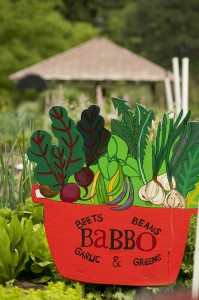Mario Batali’s Edible Garden Recipe of the Day: Spaghetti with Escarole, Guanciale, and White Beans
Posted in Mario Batali's Edible Garden on September 16 2011, by Ann Rafalko
From August 27 – September 25, families can explore Mario Batali’s Edible Garden in the Ruth Rea Howell Family Garden and enjoy daily gardening activities and cooking demonstrations showcasing kid-friendly recipes with the chance to sample and search for ingredients in the garden. We are posting the recipes from Mario Batali’s Edible Garden here on the NYBG blog, Plant Talk, so check back often.
Spaghetti with Escarole, Guanciale, and White Beans
Matt Molina, Executive Chef, Osteria Mozza
 4 tablespoons extra virgin olive oil
4 tablespoons extra virgin olive oil
8 ounces guanciale or pancetta, cut into 1/4-inch thick, 2 inch long batons
6 cloves garlic, thinly sliced
1 teaspoon red pepper flakes
1 cup cooked, drained, white beans
2 heads escarole, cut into 2-inch pieces, washed, and spun dry
1 pound spaghetti
2 tablespoons pecorino romano, grated, plus a wedge for grating
2 tablespoons Parmigiano Reggiano, grated
4 tablespoons toasted breadcrumbs
Bring 6 quarts of water to a boil in a large pot, and add 6 tablespoons salt.
Meanwhile, in a 14-inch sauté pan, heat the guanciale over low heat. Cook slowly until the fat has been rendered and the meat is golden brown, about 5 minutes. Add garlic and red pepper flakes and cook gently until garlic is golden brown, about 1 minute. Turn off the heat, add the white beans and a half cup of the boiling water.
When the water comes to a boil, add the escarole and cook for 1 minute. Using a slotted spoon, remove the wilted escarole from the water and add to the pan with guanciale.
When the water is boiling, add the spaghetti and cook until just al dente.
About 1 minute before the pasta is done, place the sauce over high heat. Immediately add pasta to the pan with the sauce, reserving 1 cup of the pasta water. Cook the pasta with the sauce for 2 minutes, stirring with a rubber spatula or tongs to coat the pasta, adding some of the reserved pasta water if the pasta so that the pasta is slippery and glistening. Remove from heat and stir in the grated Parmigiano Reggiano and pecorino romano. Add the olive oil, stirring and shaking the pan to emulsify the sauce.
Use tongs to lift the spaghetti out of the pan and onto the center of each four plates, dividing the pasta evenly, and twirling it as it falls onto the plate to form a tight mound. Spoon any sauce left in the pan over the pasta and use a microplane or fine grater to grate a light layer of pecorino romano over each plate. Sprinkle a tablespoon of toasted breadcrumbs over each plate and serve.


What are the 2 inch batons for?